#Paris 1924
Explore tagged Tumblr posts
Text
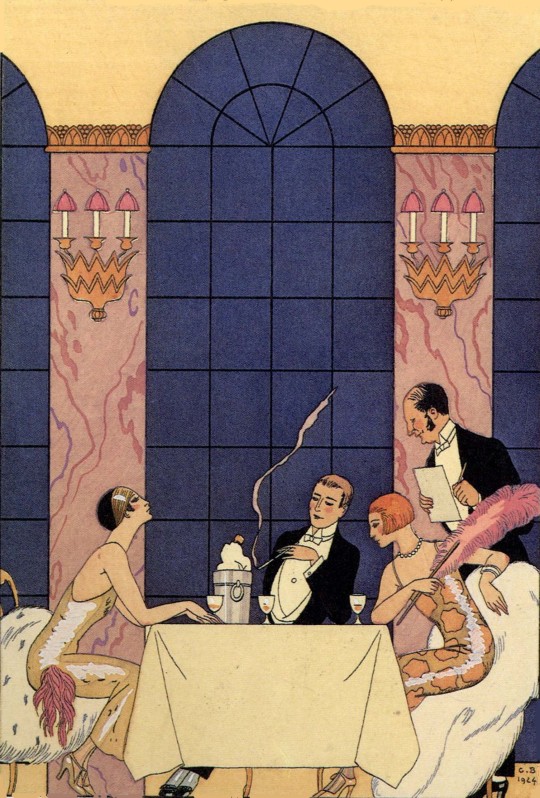
George Barbier, La Gourmandise (The Greedy). 1924
Hand-coloured, plate-signed pochoir from Falbalas & Fanfreluches: "The Gourmand/Gluttony" (The Greedy), part of the set "The Seven Deadly Sins " from the Almanac of 1925. One can nearly breathe in the heightened elegance not just through the elevated ceilings but in the exquisite dresses of the women waiting to be pampered beyond expectation with the best of French Cuisine. As is Barbier's inimitable style, the men are mere props to the confident curves of the New Woman, and from their take-charge poses we connect with the very tenor of their emerging social dominance and confidence. This famous series of illustrated almanacs was produced from 1922 to 1926 only and depicted high-society life in the fashion, social and artistic capital of the early inter-war years in Paris. Each issue contained a small diary and notation section, an introduction by one of the leading social/cultural doyens of the day, a decorative cover and twelve fashion plates (one for each month of the year). (x)
#george barbier#1924#illustration#art deco#barbier#the greedy#paris#paris 1924#jazz age#art deco illustration#deco#art deco style#1920s#20s#fashion#style#Gluttony#The Seven Deadly Sins#alamanac#20s paris#20s lifestyle#classy#elegance#20s elegance#seven deadly sins#seven sins#sins#Georges Augustin Barbier#art#painting
121 notes
·
View notes
Text
Sport et taphophilie

Le cimetière des soldats allemands de Motta Sant'Anastasia, un des lieux les plus propres de Sicile. (article associé)


0 notes
Text
Paris 1924: Golden USA upset France to create history
It is 100 years since a squad made up almost exclusively of Californian students stunned hosts France to claim back-to-back Olympic titles and cement their place in the World Rugby Hall of Fame. Continue reading Paris 1924: Golden USA upset France to create history
0 notes
Text
En jeu ! Les artistes et le sport
Aperçu de l'exposition En jeux ! au Musée Marmottan- Monet pour célébrer les jeux olympiques en mettant en perspective le sport et les artistes de 1870 à 1930.
(1870-1930) Profitant des Jeux Olympiques organisés à Paris, avec l’accord du Comité de l’Organisation de Paris, le Musée Marmottan-Monet a choisi de présenter le rapport entre sport et artistes peintres. Degas et Manet avaient habitué leur public à assister aux courses de chevaux. Mais, l’exposition explore les rapports entre art et sport, entre 1870 et 1930, à partir d’une cent soixantaines…

View On WordPress
#a Réunion des musées nationaux#Ariste#art#Art du XIX é#Art du XXè siècle#Artistes#Chroniques culturelles#Exposition#Expositions#Impressionnisme#Impressionnistes#Jeux Olympiques#JO#Loisirs#Musée#Paris#Paris 1924#Paris 2024#Peintre#Peintres#Peinture#Peintures#sculpture#Sculptures#Sport#Sportif#Sportifs
0 notes
Text

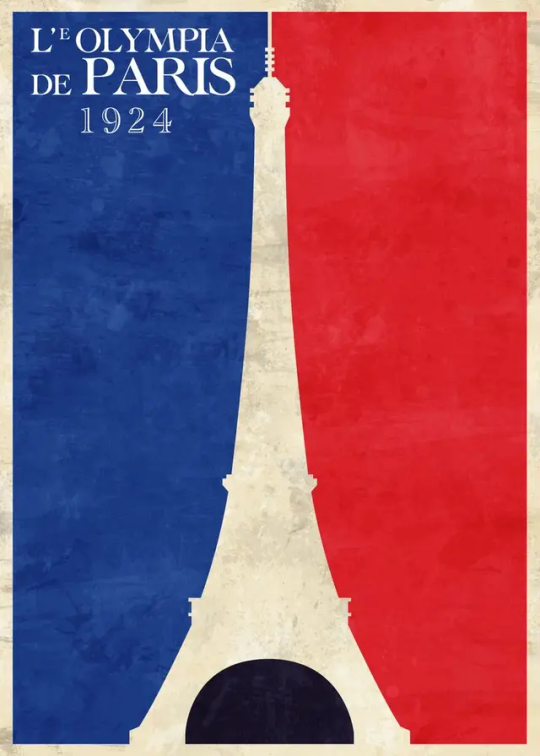








364 notes
·
View notes
Text

THE LIVING AGE, August 2, 1924
69 notes
·
View notes
Photo

Man Ray. Self-portrait. Paris, 1924
Follow my new AI-related project «Collective memories»
#BW#Black and White#Preto e Branco#Noir et Blanc#黒と白#Schwarzweiß#retro#vintage#Man Ray#Paris#1924#1920s#20s#self-portrait#autoportrait#Selbstportrait#auto-retrato
59 notes
·
View notes
Text
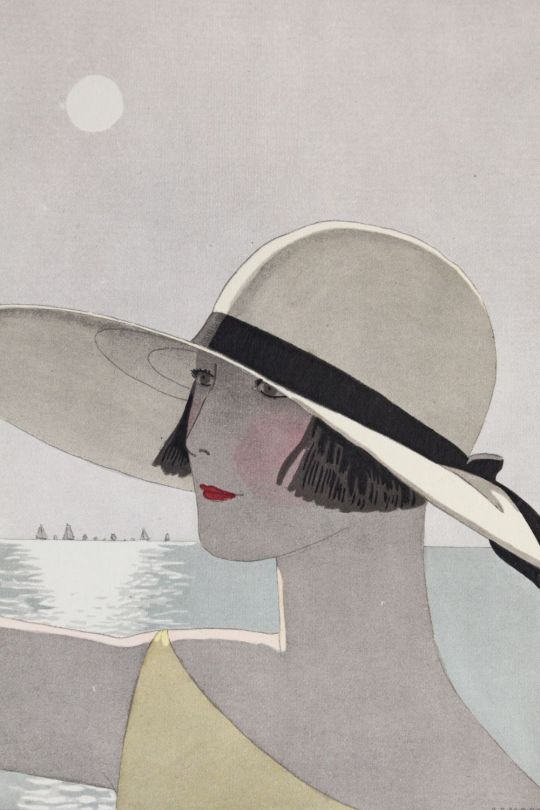
André-Edouard Marty, Sur la digue. Chapeau, de Marthe Collot (On the dike. Hat by Marthe Collot), detail, La Gazette du Bon ton, 1924-1925.
#André-Edouard Marty#1924#illustration#marthe collot#gazette du bon ton#1920s#hat#hats#big hats#chapeau#summer#summer fashion#fashion#parisian chic#chic#paris#paris fashion#summer hats#marty#summer in paris#french fashion#art deco#art deco illustration#jazz age#the roaring twenties#20s fashion#20s hats#20s paris#bob#andre edouard marty
91 notes
·
View notes
Text

British athlete Douglas Lowe shakes hands with Swiss athlete Paul Martin following the final of the men's 800m event of the 1924 Paris Olympics
41 notes
·
View notes
Text



this Paris looks soooo cunty, playing his instrument and moping about on the mountains with his dog and cattle, and then here comes 'mein guter Vater' Agelaus with a flower crown saying "My Paris, why do you always seek solitude? Accompany me to the festival in Troy."
Fuck me I guess. I am going to watch this whole movie aren't I.
#capri talks#paris of troy#agelaus#tagamemnon#Helena (1924)#silent film#THE MAKEUP I am in love oh my gosh. theatrical makeup on paris <3#for the record: I am NOT watching this right now because it is late and I don't have three hours (!!!) to spare atm.#however I am definitely too intrigued to not NOT watch it. this is all your fault littlesparklight look what you've done to me /s#stay tuned for a live blogging of this at some point in the near future!#(I will not clutter the main tags with it ofc lol. I'll make a first impressions tag)
15 notes
·
View notes
Text
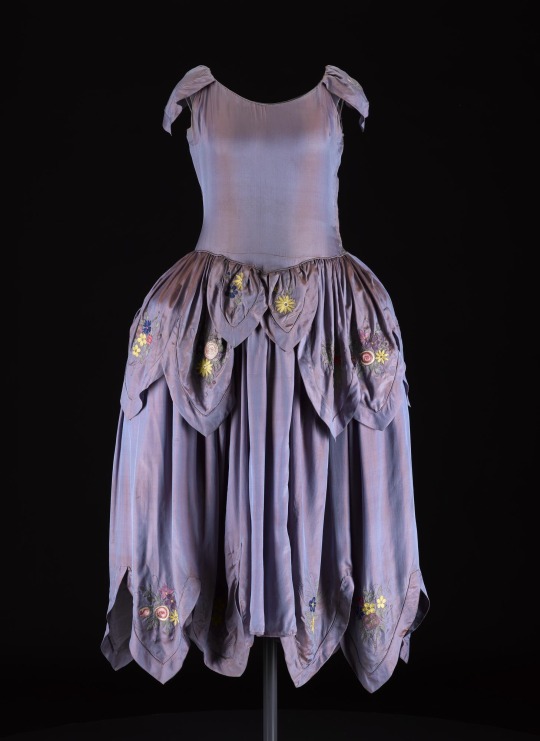
Purple Silk Robe de Style, ca. 1924, French.
Designed by Lanvin.
National Museums Scotland.
#robe de style#Lanvin#french#Paris#France#1920s#1920s France#1920s dress#1924#purple#silk#national museums scotland#womenswear#extant garments#dress#20th century#third republic#1920s extant garment
209 notes
·
View notes
Text

Street scene in Sons-et-Ronchères, Picardy region of France
French vintage postcard, mailed in 1924 to Paris
#france#tarjeta#postkaart#sepia#ronchres#carte postale#ansichtskarte#scene#1924#mailed#briefkaart#region#photo#photography#picardy#postal#postkarte#paris#vintage#french#postcard#historic#street#sons#ephemera
7 notes
·
View notes
Text
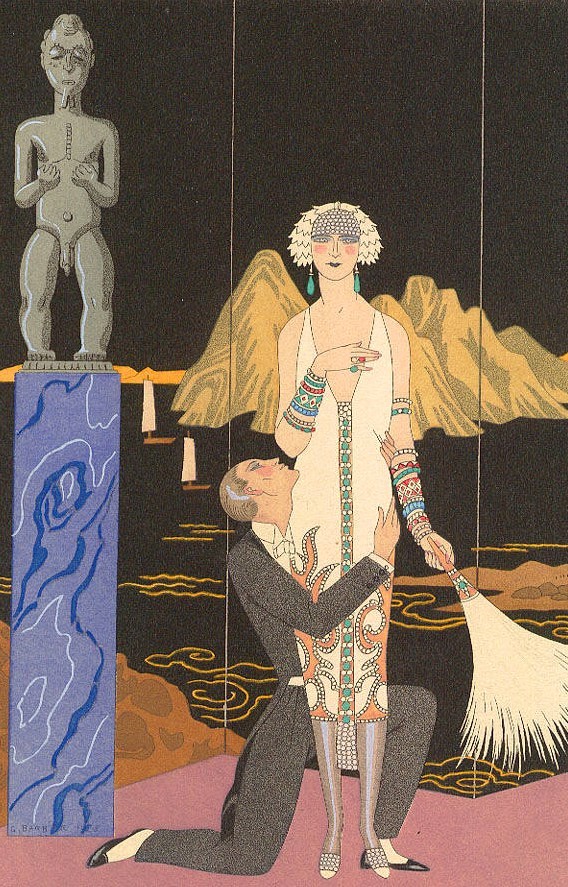
1924 George Barbier, Le Soir (Evening), Falbalas et fanfreluches: almanach des modes présentes, passées et futures.
"Art Deco Costumes By George Barbier" (Introduction by Madeleine Ginsburg, Curator, V&A Museum, London)
#1924#illustration#george barbier#barbier#art deco#african art deco#Falbalas & Fanfreluches#high-society paris#high-society life#high-society#parisian life#parisian fashion#parisian chic#art deco costumes#art deco illustration#parisian high-society#Falbalas et fanfreluches#Georges Augustin Barbier#flapper
66 notes
·
View notes
Text

#olympics#olympic games#jeux olympiques#paris#1924#history#javelin#les olympiades#olympiad#europe#european#france
112 notes
·
View notes
Text



On the images: the book ENOUÊTE JUDICIAIRE SUR L'ASSASSINAT DE la Famille Impériale Russe' by Nicolas Sokoloff, published by Payot (France) in 1924
Two books of the investigator N. A. Sokolov - second hand sources
I've just realised that people often refer to 'the book' supposedly by the investigator N.A. Sokolov who in February 1919 was appointed by Kolchak to investigate the murder case of the Imperial Family. It appears that some people are under the impression that this book is the primary source of information on the case. This needs clarification.
N. A. Sokolov was not the first investigator of the case.
The first investigator of the case was Aleksei Dmitrievich Nametkin (1875-1919) - investigator of the most important cases, Ekaterinburg District Court, collegiate assessor. He started the investigation on 30 July 1918. He was the one who went to Ganina Pit and Koptyaki with white officers.
The second investigator was Ivan Alexandrovich Sergeev (1872-1919) - he was appointed the investigator for the case on 13 August 1918. He was the one who provided the description of rooms in the Ipatievsky House and also interrogated Pavel Medvedev, the commander of the outside guards in Ipatievsky House, along other indirect witnesses. Note: Pavel Medvedev was the ONLY direct witness with his story ever interrogated by any of the investigators in 1918-1919.
N.A. Sokolov (1882-1924) was the third and final investigator of the case. He was appointed by the Military Dictator, Kolchak, to 'prove' the death of Nicolas II and his Family in Ipatievsky house. The reason being that the previous investigators were not quite agreeable with his course of action. They wanted to solve the case not to prove that Nicolas II and his family were killed.
To the existing investigation papers collected by the two previous investigators N.A. Sokolov added his own papers and 'evidence'. Note: Sokolov was appointed the investigator in February 1919 - 8 months after the 'murder'.
In July 1919, Sokolov together with the whites retreated to Harbin, China. Later, he immigrated to France, taking the investigation materials - 7 volumes, with him.
In France, some of the investigation materials (not all), were published in the book called 'ENOUÊTE JUDICIAIRE SUR L'ASSASSINAT DE la Famille Impériale Russe' by Nicolas Sokoloff. The book was published in French by the Publishing house Payot, in 1924. Obviously, N.A. Sokolov did not speak French, so the book was put together, edited, and translated by someone else. By whom is not mentioned in the book.
On 24 November 1924 N.A. Sokolov was found dead in his garden in Paris. The cause of death was not established. However, 'official' version was a heart attack.
In 1925, Publishing house 'Slovo' in Berlin published the book 'Убиiство царской семьи' putting as an author N. Sokolov. The book put together in Russian differs from the one in French. Who put the Russian text together, and edited is not stated in the book.
Important: both books contain only a fraction of the investigation materials contained in 7 volumes of the original investigation. Both books do not state the editors, translators, and how the material was provided for publishing. Both books do not state the full official name of the author - N.A. Sokolov. Nicolas Sokoloff and N. Sokolov can be anybody really. Sokolov's full name was Nikolai Alekseevich Sokolov.
Taking the above into consideration, the book by 'Sokoloff/Sokolov' cannot be relied on as the only source of the information in this case. Mainly because it does not offer the full investigation material of the case.

On the image: a spread of the book 'Убиiство царской семьи' by N. Sokolov published by publishing hosue 'Slovo' in Berlin in 1925
#romanovs#research#seraphima bogomolova#investigation#nicolas ii#evidence#murder mystery#books#N.A. Sokolov#payot#1924#Berlin#Paris#Slovo
3 notes
·
View notes



